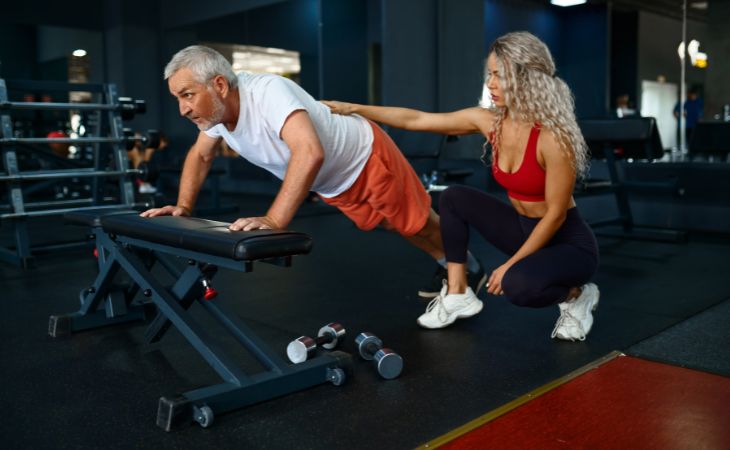If you’re planning to take an extended break from your physical activity routine due to a vacation, or you’re forced to because of an injury or illness, you probably know that recovery and returning to activity can be especially challenging. On one hand, giving the body rest after physical exertion is essential and even necessary for the healthy building and recovery of muscles, but when this break becomes prolonged, it triggers the start of a natural biological process of decline and deterioration in the body's ability to perform high-intensity physical activities. So what actually happens when we decide or are forced to stop exercising? How long does it take for our fitness to deteriorate and affect our performance? And what can be done to maintain physical fitness during a long period of rest? All the answers are ahead of you.
1. Your heart's fitness will decline after just one week
When we engage in regular aerobic activity over a long period of time, we train our body to better utilize the oxygen around it and optimize its ability to absorb and consume oxygen to improve performance. However, this ability, achieved through much effort by professional or amateur athletes and can take months or even years, can be impaired in just one week of inactivity. When we rest for several days, our heart's ability to function during aerobic activity begins to gradually decline – on the first day, the blood volume in the muscles decreases by 5%, and after two weeks it can lose up to 20%. After 3-4 weeks, the resting heart rate increases by 4 to 15 beats per minute, and after 6 weeks, there is a decline of about 40% in our physical fitness.
However, the good news is that regular exercisers can take comfort in the fact that an extended break from physical activity won’t quickly bring them back to “square one,” especially compared to beginners. To put things in perspective, a person who has been training consistently for two years and a beginner who started their training routine in the last six months will both lose about 40% of their fitness after 6 weeks of break. However, from this point onward, the deterioration rate will be much slower for the regular exerciser than for the beginner.

2. Your flexibility will deteriorate after just 3 days
Flexibility is one of the first physical abilities we lose when we stop exercising. After physical activity, the stretched muscles and tendons start returning to their original form – and this process is even more pronounced if our daily routine is mostly sedentary (e.g., office work). After three days, you may notice slight changes in your flexibility, with more significant and noticeable changes occurring after two weeks of rest. If you want to maintain flexibility during this time, and assuming you’re able to do so, it’s recommended to perform short stretching exercises daily or at least three times a week.
3. You will lose power first, and then strength
Have you ever wondered what the difference is between strength and power? Well, strength is your ability to overcome resistance (i.e., how much weight you can lift), while power is defined as your ability to overcome resistance in the shortest time possible (i.e., how quickly you can lift a weight of X kg). When you are on a break, both strength and power decline; muscle strength starts to diminish after 72 hours without exercise due to changes in structure and protein loss, but the peak comes after about 2-3 weeks when these changes become more noticeable and affect performance. On the other hand, loss of power happens quickly, and within a few days, you can feel changes in the ability to generate nerve impulse (i.e., enough energy to move the muscle).
For example, someone who returns to lifting weights after several days of rest will be able to lift the same weights they did before, but the physical load they feel will be greater due to the loss of power. That person will have to exert more effort during the workout, requiring longer breaks between sets, and even longer rest periods between workout days.

4. Fitness deteriorates faster during illness
A healthy person who stops exercising loses fitness at a slower rate than someone who stops due to illness or injury – the latter loses fitness at nearly twice the rate of a healthy individual. The physical and mental stress that accompanies illness or injury takes a bigger toll on the body during the lack of physical activity, and as a result, recovery takes longer. If you’re an athlete recovering from a fracture, surgery, or prolonged illness, it may take you 12 to 24 months of rehabilitation and recovery to regain your previous fitness level.
5. Older adults lose fitness at up to twice the rate of younger people
The fact that older adults lose fitness faster than younger individuals is due to the decline in hormone levels in their bodies. As we age, our levels of growth hormones (HGH) decrease, making muscle recovery and healing more difficult. Additionally, this affects recovery time, which becomes longer due to the fact that older people tend to experience more fatigue after workouts – according to a study conducted by the Institute for Health Sciences at the University of Tasmania in Australia and published in the Journal of Aging and Physical Activity.

Important to know: Maintaining fitness isn’t as hard as it sounds!
Now that you know the consequences of stopping physical activity, you’re probably wondering how to minimize or slow down fitness decline during rest. If you’re planning to take a break from your regular training routine soon, it’s important to understand that maintaining fitness isn’t an “all or nothing” situation. In fact, you’ll be surprised to learn that you can maintain your fitness level in small doses. One way to do this is by performing a "Tabata" (HIIT - high-intensity interval training) workout for 15-20 minutes once every two weeks. This will help maintain your fitness and slow down the decline in aerobic or muscle capacity until you’re able to return to full activity. However, it’s important to ensure that this workout is indeed high-intensity, reaching 80-90% of your heart rate to be effective.
Want to learn more about HIIT workouts and try them for yourself? We’ve gathered everything you need for it:



